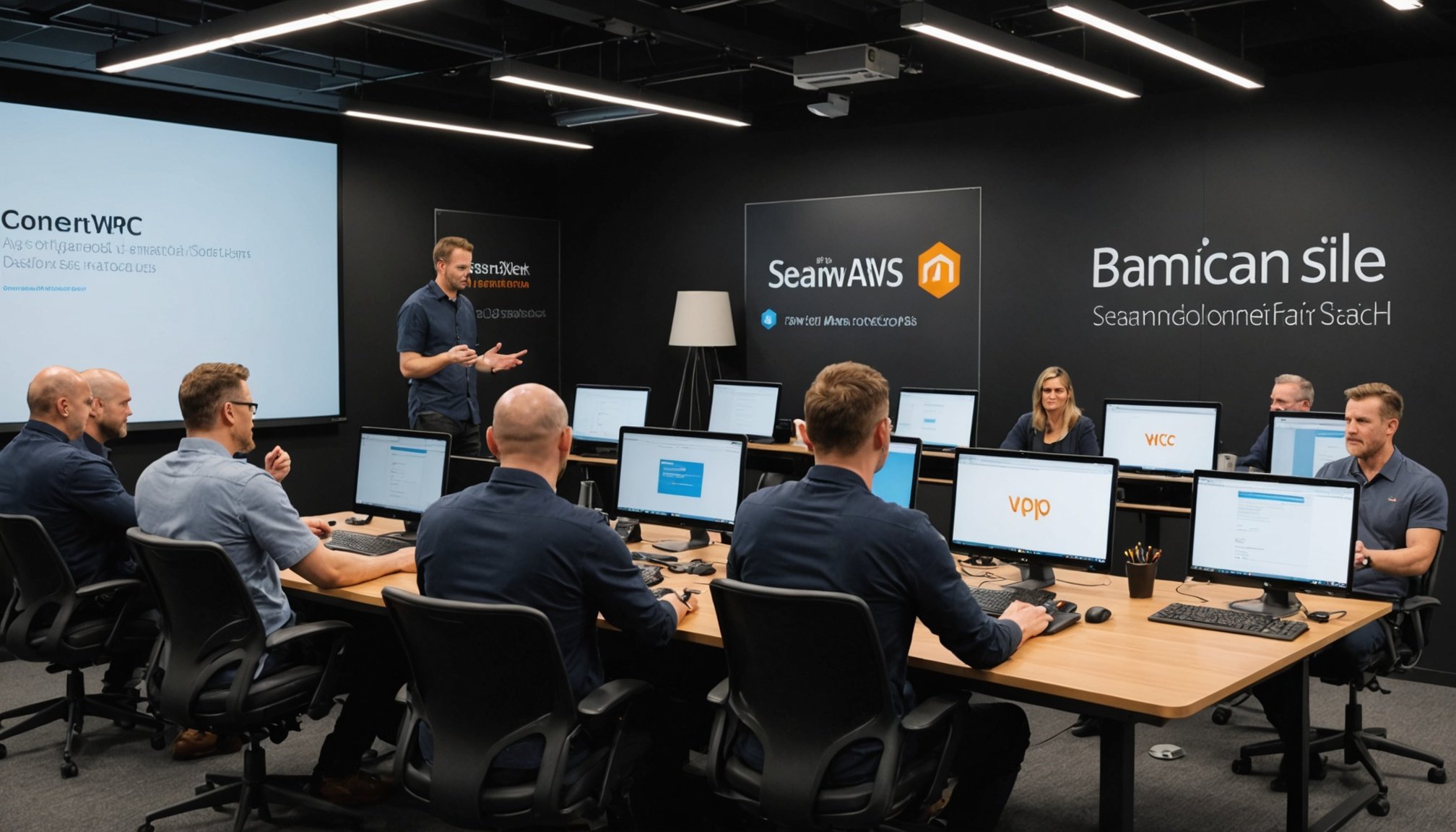Understanding Site-to-Site VPN Concepts
Site-to-Site VPN plays a crucial role in cloud networking, enabling secure and seamless connectivity between on-premises networks and cloud environments such as AWS. It allows businesses to extend their data centres to the cloud securely, providing a pathway for a diversified yet integrated network infrastructure.
AWS VPC and Hybrid Networking
The Amazon Virtual Private Cloud (VPC) offers a robust platform for hybrid infrastructure solutions, facilitating the creation of a logically isolated network in the AWS cloud. With Site-to-Site VPN, you can establish a secure tunnel between your corporate network and AWS VPC, allowing both networks to communicate as if they were part of a single, expansive infrastructure.
This might interest you : Top Tactics for Implementing Robust Rate Limiting in Your RESTful API
Benefits of Connecting On-Premises Networks to AWS VPC
Connecting on-premises networks to AWS VPC using Site-to-Site VPN offers several key benefits:
- Scalability: Easily expand your network to include AWS cloud resources without major overhauls.
- Security: Utilize AWS’s advanced security features, ensuring that data transferred over the VPN remains encrypted and protected.
- Flexibility: Enabling hybrid networking allows businesses to leverage cloud computing power while maintaining on-premises operations.
Through the integration of Site-to-Site VPN with AWS VPC, businesses can enhance their IT architecture, optimizing both cost and performance, while ensuring secure, reliable connectivity.
Also to read : Ultimate Walkthrough: How to Securely Set Up an OpenLDAP Server on Ubuntu
Prerequisites for Setting Up a Site-to-Site VPN
Before initiating a VPN Setup, understanding essential prerequisites is crucial. Setting up a Site-to-Site VPN involves several VPN Setup Requirements, including correctly configuring network elements on both ends.
Required AWS Services and Resources
An AWS account is the first requirement, alongside a sound grasp of AWS Account Setup. In AWS, services like Amazon Virtual Private Cloud (VPC) and the AWS Direct Connect are pivotal for VPN connections. You need to create a virtual private gateway within your VPC, acting as the VPN endpoint in the AWS cloud. This component is central to establishing a stable connection.
Network Configuration on the On-Premises Side
The on-premises network must have a configured customer gateway device, which links your infrastructure to the AWS cloud. This setup mandates careful planning and execution to ensure seamless network configuration and avoid connectivity issues. Configurations for suitable IP addressing schemes and security policies should be predetermined to facilitate smooth data flow.
AWS Account Setup Considerations
Moreover, ensure your AWS account is properly set up to support VPC creation and management. Familiarize yourself with IAM policies, as these secure resources and grant necessary permissions for VPN deployment. Ensure appropriate roles are assigned, giving users adequate access to manage the configurations efficiently. Tailoring these facets aligns your preparations for a successful Site-to-Site VPN setup.
Step-by-Step Guide to Configuring AWS Site-to-Site VPN
Establishing an AWS Site-to-Site VPN requires careful planning and precise execution. By following a step-by-step guide, you can ensure a seamless AWS VPN configuration process.
Creating a Virtual Private Gateway
Begin by creating a Virtual Private Gateway in your AWS Management Console. This component acts as the anchor on the AWS side and facilitates secure connections between your on-premises network and AWS VPC. Proceed to attach the gateway to your desired VPC to enable private networking.
Configuring Customer Gateway and VPN Connection
Next, configure the Customer Gateway on your on-premises side. This involves setting up the device with a static, public IP address that AWS can access. Once the gateway is ready, establish a VPN connection by defining the VPN settings in AWS to match those of your customer gateway device. Specifications like shared secrets for encryption facilitate secure data transmission.
Establishing Routing and Security Policies
Configuring routing protocols is crucial for a robust Site-to-Site VPN setup. Define static or dynamic routing policies that align with your existing network architecture, ensuring efficient data flow. Implement security policies, such as IPSec encryption and trusted IP addresses, to safeguard communications. By meticulously following these steps, your network setup for AWS Site-to-Site VPN will be both secure and proficient.
Best Practices for Site-to-Site VPN Implementation
Implementing Site-to-Site VPN effectively requires adhering to key best practices to ensure optimal network security and performance. First and foremost, it is essential to apply recommended configurations that enhance both security and performance optimization. This includes utilizing strong encryption protocols like IPSec and employing multi-factor authentication to safeguard data integrity and access.
Regular monitoring and updating of VPN settings are pivotal. Security threats are constantly evolving, and these updates help mitigate potential vulnerabilities. Implement automated monitoring tools to detect and respond to anomalous activities swiftly. Regular reviews and updates fortify the VPN against emerging threats.
Scaling the VPN architecture is crucial as your network infrastructure grows. Adopt strategies like using dynamic routing protocols for flexibility and scalability, ensuring that the system can handle increased loads and maintain efficient data flow.
By adhering to these VPN best practices, businesses can maintain a secure, resilient, and high-performing Site-to-Site VPN setup. Integrating these strategies empowers businesses to leverage cloud solutions effectively while safeguarding their network infrastructure.
Troubleshooting Common Issues
Setting up a Site-to-Site VPN can sometimes result in challenges, particularly with connectivity issues. Identifying the root cause is essential for effective VPN troubleshooting. An example of a frequent issue is incorrect configuration settings which can disrupt the connection. Ensure both ends have compatible configurations to resolve this effectively.
To diagnose and resolve VPN problems swiftly, employ tools like AWS CloudWatch and Network Manager. These provide visibility into network health and can highlight inconsistencies, helping you isolate and correct faults. For instance, mismatched encryption settings can lead to unsuccessful connections, which can be rectified by aligning settings between the endpoints.
If issues persist beyond basic troubleshooting, seeking assistance through AWS Support or consulting community forums can be invaluable. AWS offers robust support options, including forums and documentation, where users can share insights and solutions. This community knowledge could offer alternative approaches to tackling your specific issue.
Remember, systematic and calm problem-solving improves the situation considerably. By leveraging AWS tools and community resources, you can efficiently resolve connectivity issues and ensure your VPN setup continues to function smoothly.
Use Cases and Scenarios for Site-to-Site VPN
Site-to-Site VPN is an integral tool for facilitating cloud integration and enabling seamless hybrid applications. It empowers organisations to connect dispersed operational arms securely and efficiently. But what real-world scenarios showcase its effectiveness?
One illustrative example is multinational corporations needing to unify geographically isolated branches. By implementing Site-to-Site VPNs, these businesses achieve reliable, secure communication across locations, making collaboration effortless, enhancing overall productivity and streamlining operations.
Further, companies with hybrid IT infrastructures, merging both on-premises and cloud resources, stand to gain significantly. A fantastic example involves manufacturing firms, running IoT applications in cloud environments that demand robust, continuous data flow from factory devices. Utilising Site-to-Site VPN mechanisms, these entities can tap into cloud capabilities, handle extensive data arrays, and integrate analytics solutions without compromising security.
Looking ahead, the trend indicates increased adoption in diverse sectors such as healthcare and finance, where data sensitivity and cross-regional operations are vital considerations. Hybrid networking solutions will likely continue evolving with Site-to-Site VPNs at the crux, marrying flexibility, security, and scalability. As cloud solutions fortify, so does the potential for deploying advanced Site-to-Site VPN architectures, facilitating secure global networks of the future.
Additional Resources and Learning Materials
Expanding your knowledge of AWS and VPN configurations is crucial for achieving proficiency in setting up and managing Site-to-Site VPNs. Thankfully, a wealth of AWS documentation is available to guide you through the intricacies of VPN setup and management.
For those interested in structured learning, engaging in online courses and tutorials can be particularly beneficial. Platforms offering video tutorials provide an interactive approach to understanding both basic and advanced networking concepts. These resources often offer a blend of theory and practical exercises, making them ideal for hands-on learners.
Additionally, there are numerous reference materials for enthusiasts aiming to delve deeper into advanced cloud networking subjects. Books and white papers that focus on the technical and strategic aspects of hybrid networking can provide further insights. These materials are invaluable for those who wish to grasp the broader implications and future trends associated with Site-to-Site VPNs and hybrid cloud solutions.
Exploring these resources not only enhances your technical skills but also ensures you remain updated with the latest cloud networking developments. By continually learning, you can effectively optimize your infrastructure and leverage the full capabilities of AWS for a robust and secure connectivity experience.










